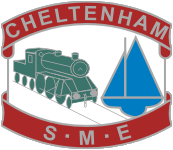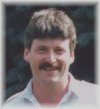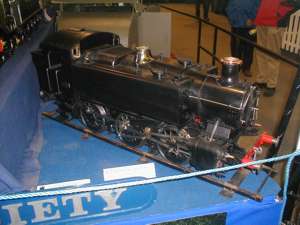The location of the buffer beam brackets is questionable. Photographs of all 1500T Class engines clearly shows that the buffer stock is the same height as the front buffer beam. However, the two are not the same on 'Paddington'. I have decided the best course of action is to centralise the front buffer stock vertically in the buffer beam.
There is a group of ten 'G' holes along the top of the frames, behind the centre axlebox position, that are for the Rear Side Tank Support bracket. The relative positions of the ten holes DOES NOT match the hole positions dimensioned on the Rear Side Tank Support bracket on Sheet 4.
Also, the datum dimension which has been changed to 4" seems incorrect. With the dimensions of the location of the matching support plate on the tanks, I think the dimension should be nearer 3.75" (which may have been the original dimension).
The group of five holes ahead of the centre axlebox position and immediately behind the large weighshaft hole for the Rear Motion Bracket Support have had the datum dimension changed to 2.875". With this dimension the lower hole of the front row falls into the weighshaft hole. Also, the Front Motion Bracket Support position of 1.750" behind the front axle, and the Motion Gear Stretcher position of 2.5625" ahead of the centre axle, is correct for the size of the Motion Bracket. However, the resulting position of the Rear Motion Bracket is completely wrong. A fixing screw position of 2.625" seems more correct than the amended dimension of 2.875". This would certainly correct the problem with the weighshaft hole. So many holes in my frames to be possibly filled and re-drilled :(
Just ahead of the 'M' hole, there is a group of 17 holes (top row of 5 holes that also hold the cab floor, plus two rows of 6 holes). The drawing asks for a No.29 drill hole (4BA Clear). The bottom 2 holes of the back row of 6 holes would be better drilled for a 4BA tapped hole, as 4BA nuts on the inside of the frames foul the Sander Handle Support Bracket fitted to the 'K' holes inside the frames.
There is a line of four holes (No 29 drill 0.5" apart) directly above the brakeshaft inner bearing holes for fixing the Cab Step Stretcher (marked 'z'). As they stand these four fixings are offset to one side of the stretcher and need moving 0.062" to the rear (right on the drawing) in order to centralise them (perhaps they should be offset?).
The top two 'H' holes for the sanding gear Bellcrank are superfluous if the bellcrank bracket on Sheet 8 is correct.
The two right hand fixing holes for the upper Rear Drawbeam Stretcher (i.e the two fixings that DO NOT hold the Corner Bracket) on the Right Hand Side frame only need to be suitable for countersunk screws as these positions foul the fixing brackets for the Rear Frame Toolbox.
There
are two holes slightly above and to the left of the 'ac' fitting (Brakeshaft Bearing). I have NO IDEA for what these holes are used.
The large rectangular slot through which the rear sandbox levers pass does not have a dimension for its position from the top of the frame. I think the top of the slot should be 1.907" from the top of the frame.
There is a pattern of six (6) fixing holes for holding the Front Beam Support Bracket which are dimensioned 1 31/32" back from the front axle centre line. This dimension brings the front fixing screws right in the corner of the brackets. I think this dimension would be better increased to 2 1/16".
|




